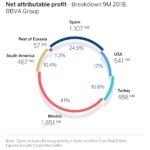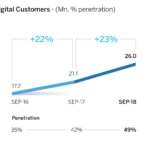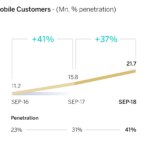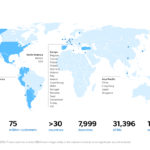BBVA earns €4.32 billion in the first nine months
• Transformation: Digital and mobile customers as well as digital sales continued to grow across all geographies, with a positive impact on efficiency. Digital customers now account for 49% of the total, very close to the year-end target of having half of the customers banking through digital channels
• Income: Operating income improved (+5.8 percent at constant exchange rates), driven by a positive trend in recurring revenues and containment in operating expenses. BBVA’s ROE between January and September was 12.2 percent, with ROTE standing at 14.8 percent
• Risks: The NPL ratio was 4.1 percent in September (4.4 percent in June). Coverage ratio reached 73 percent
• Capital: Despite a complex environment, the fully-loaded CET1 ratio stood at 11.34 percent. During the first nine months of the year, the tangible book value per share plus dividends grew 7.2 percent to €5.95

The BBVA Group posted a net attributable profit of €4.32 billion during the first nine months of 2018, up 25.3 percent from the same period a year earlier (+43 percent at constant exchange rates). A surge in recurring revenues, cost containment efforts, lower impairment losses and capital gains of €633 million from the sale of BBVA Chile have all contributed to this result.
“In spite of a challenging situation in Turkey and Argentina, the results we are presenting today reveal the strength of our business model and geographic diversification. These results are underpinned by the progress achieved in the bank’s transformation, a comfortable capital position and solid risk indicators,” BBVA CEO Carlos Torres Vila said.
Net interest income for the first nine months of the year stood at €12.9 billion (-2.3 percent yoy, +10.2 percent at constant exchange rates), while commissions and fees reached €3.65 billion (-1.4 percent yoy, +9.4 percent at constant exchange rates). Both line items – recurring revenues – reached €16.55 billion (-2.1 percent yoy, +10.1 percent at constant exchange rates), which drove the gross income to €17.6 billion (-6.9 percent yoy, +4.3 percent at constant exchange rates).
Operating expenses between between January and September dropped 7.1 percent on the back of cost-discipline efforts. Excluding currency effects, operating expenses rose 2.7 percent. The efficiency ratio stood at 49.6 percent, 52 basis points lower than in 2017 at constant exchange rates. Operating income was €8.88 billion (-6.8 percent with currency impact, +5.8 percent at constant exchange rates), driven by recurring revenues and containment in operating expenses.
The Group’s net attributable profit for the year through September was €4.32 billion, up 25.3 percent compared to the same period of 2017 (+43 percent at constant exchange rates).
BBVA earned €1.67 billion in Q3-18 (+46.4 percent yoy, +70.5 percent at constant exchange rates). The quarterly figure includes capital gains on the sale of BBVA Chile and a negative impact (€-190 million) as a result of Argentina’s hyperinflation accounting adjustment.

Regarding profitability, BBVA’s ROE between January and September reached 12.2 percent compared to 9.6 percent for the same period of 2017, while the Group's ROTE stood at 14.8 percent versus 11.9 percent a year earlier. The bank remains focused on creating value for its shareholders. Despite the environment, during the first nine months of the year, the tangible book value per share plus dividends grew 7.2 percent to €5.95.
As for risk indicators, the NPL ratio in September reached 4.1 percent (versus 4.4 percent in Q2-18), its lowest level since June 2012. Coverage ratio rose to 73 percent and the cost of risk was 0.90 percent.
In terms of capital adequacy, BBVA’s capital position remained solid. The fully-loaded CET1 ratio stood during the quarter at 11.34 percent, surpassing the 11-percent target. The sale of the Group’s stake in BBVA Chile generated a positive impact on this ratio of 50 basis points. The leverage ratio as of September 30 was 6.6 percent fully-loaded, the highest among its European peer group.
In balance sheet and activity line items, the comparison was affected by the change in the scope of consolidation following the sale of BBVA Chile, which took place on July 6. Loans and advances to customers totaled €370.5 billion, (down 0.9 percent ytd), with customer deposits reaching €365.69 billion, up 0.5 percent.
An ongoing transformation
The BBVA Group’s transformation process continued, with an increase in its digital and mobile customer base, as well as in digital sales. This performance had a positive impact on efficiency. The number of digital customers increased to 26 million, up 23 percent in one year. The Group’s mobile customer base reached 21.7 million, 37 percent more than in September 2017. Digital customers now account for 49% of the total, very close to the year-end target of having half of our customers banking through digital channels. Also, unit sales through digital channels during the first nine months of the year accounted for 39.5 percent of the total, compared to just 15.3 percent from two years ago.


The key developments in each business area are detailed below.
In Banking Activity in Spain, lending fell 2 percent since the end of 2017, mainly as a result of a reduction in mortgages, public sector and large corporates. The trend in consumer finance and credit cards remained very positive (+16.8 percent ytd). Customer funds grew (+0.9 percent) compared to Dec. 2017 while off-balance-sheet funds increased 3.4 percent, with net positive contributions to investment funds. In regards to P&L, the area’s net attributable profit in the first nine months of 2018 reached €1.17 billion, up 10.5 percent yoy, driven by the favorable behavior of commissions and fees (+8 percent yoy), as well as by the drop in operating expenses and provisions. The NPL ratio dropped to 5 percent from 5.2 percent in the quarter, as a result of the decrease in the balance of non-performing loans. The coverage ratio stood at 56 percent as of September 30.
As for the Non-Core Real Estate area, net real estate exposure decreased 30 percent in 12 months to €5.46 billion. On October 10, BBVA concluded the transfer of its real estate business in Spain to Cerberus Capital Management, which will allow the bank to reduce almost entirely its real estate exposure. The transaction is not reflected in Q3 financials. The area’s losses narrowed significantly to €-60 million in the first nine months of 2018, compared to €-274 million in the same period a year earlier.
Total earnings in Spain (Banking Activity plus Non-Core Real Estate) reached €1.11 billion, up 41.5 percent than the same period of 2017.
To better explain the business trends in the areas that use a currency other than the euro, the variation rates described below refer to constant exchange rates.
In the United States, lending increased 4.9 percent compared to December 2017, driven by consumer finance and business loans. In contrast, customer deposits dropped 3.3 percent. The area generated a net attributable profit of €541 million in the first nine months of the year, up 43.2 percent from the same period of 2017. The main levers were the double-digit increase in net interest income (+12.0 percent) and lower provisions. The NPL ratio was 1.1 percent and coverage stood at 101 percent.
In Mexico, BBVA retained its clear leadership position. Lending activity increased 6 percent since December, while deposits grew by 2.1 percent. The area’s performance in the first nine months of 2018 was very positive, with a net attributable profit of €1.85 billion, up 22.5 percent yoy. Gross income grew at a yoy rate of 8 percent, while operating expenses advanced at a lower pace (+3.7 percent yoy). Regarding asset quality indicators, the NPL ratio remained unchanged during the quarter at 2 percent, while the coverage ratio stood at 149 percent.
In Turkey, Garanti Bank Turkish-lira loans saw a slowdown, while the foreign-currency loans (in U.S. dollars) continued their downward trend. Between January and September, Turkey generated a net attributable profit of €488 million, up 18.1 percent yoy. The macroeconomic environment prompted an increase in impairment losses on financial assets and cost of risk (1.72 percent in September vs. 1.23 percent in June). The NPL ratio increased from 4.5 percent in June to 5.2 percent in September, with coverage of 76 percent.
In South America, BBVA completed the sale of its stake in BBVA Chile. With a constant perimeter – excluding BBVA Chile for comparison purposes – customer loans grew 6.4 percent since December 31, 2017 and customer funds, 9.2 percent. Regarding results, besides the change in scope of consolidation due to Chile, the accounting adjustment for hyperinflation in Argentina (€-190 million) also affected the account. The region posted a net attributable profit of €467 million (-5.6 percent), including both impacts. The NPL ratio stood at 4.3 percent and the coverage ratio was 101 percent.
About BBVA

BBVA is a customer-centric global financial services group founded in 1857. The Group has a strong leadership position in the Spanish market, is the largest financial institution in Mexico, it has leading franchises in South America and the Sunbelt Region of the United States; and it is also the leading shareholder in Garanti, Turkey’s biggest bank for market capitalization. Its diversified business is focused on high-growth markets and it relies on technology as a key sustainable competitive advantage. Corporate responsibility is at the core of its business model. BBVA fosters financial education and inclusion, and supports scientific research and culture. It operates with the highest integrity, a long-term vision and applies the best practices.